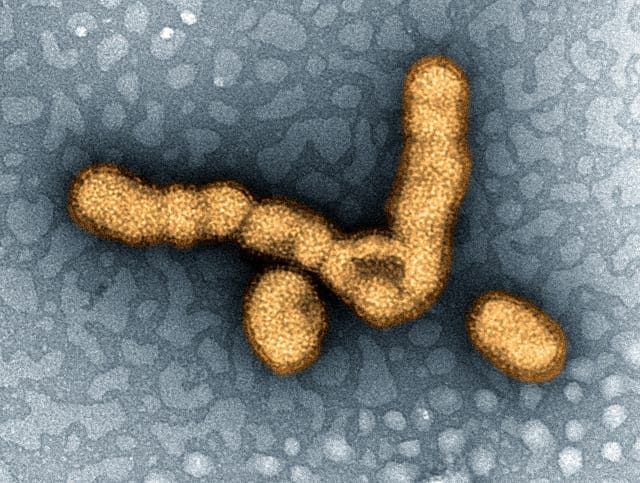Influenza scientists at five sites in the United States are to receive funding from the National Institute of Allergy and Infectious Diseases (NIAID) to collaborate with investigators around the globe in a network designed to advance understanding of influenza viruses and how they cause disease.
In addition to basic research, investigators in the Centers of Excellence for Influenza Research and Surveillance (CEIRS) network also conduct domestic and international influenza surveillance studies with an emphasis on rapid characterization of viruses that have the potential to cause pandemics. The first CEIRS network was launched in 2007 by NIAID, part of the National Institutes of Health. NIAID today announced awards of the new contracts to continue the program for seven years.
“The CEIRS network exemplifies NIAID’s dual mission of conducting basic and applied influenza research, while maintaining the ability to respond rapidly in the event of an emerging public health threat,” said NIAID Director Anthony S. Fauci, M.D. “CEIRS investigators have contributed greatly to our understanding of how influenza viruses emerge from wild and domestic animals, their adaptation to and global circulation throughout the human population and the interplay between the viruses and human immune responses.” Dr. Fauci added that the CEIRS network also played a critical role in the nation’s response to the 2009 H1N1 influenza pandemic by, for example, quickly characterizing the virus and performing pre-clinical testing of candidate vaccines.
The geographic range of sample collection sites will be more tightly focused than previously on those regions where new influenza viruses are likely to emerge and the network will further integrate basic research with surveillance data gathering, said CEIRS project officer Diane Post, Ph.D., of NIAID’s Division of Microbiology and Infectious Diseases.
“A key mission of the CEIRS network is to foster innovative and collaborative basic research on influenza viruses, including how they evolve and adapt to animal and human hosts. The information we gain could help us understand why influenza pandemics occur and could assist health officials in taking steps to mitigate outbreaks,” Dr. Post said.
Four of the new CEIRS contracts are to institutions that had received a 2007 award. One institution, Johns Hopkins University, will establish a new center. All will conduct surveillance and basic research projects. The network has a global reach, with collaborations established or planned at more than two dozen sites in Asia, Southeast Asia, the Middle East, South America, Europe and Australia. Funding for the first year of the contracts will total approximately $23 million.
“Proposed work from all five centers involves new and exciting research programs that hold the promise to answer fundamental questions pertaining to influenza in animals and people,” said Dr. Post.
The centers are based at:
Emory University, Atlanta
Emory-UGA Center of Excellence for Influenza Research and Surveillance (CEIRS): In partnership with the University of Georgia (UGA), Emory University studies will focus on surveillance of swine influenza viruses and investigations of swine immune responses to virus infection. With collaborators in China, animal surveillance efforts will include swine and poultry. Basic research projects at Emory-UGA CEIRS will include efforts to better understand the human immune response to influenza vaccination, including responses of pregnant women. Planned studies of long-lasting flu antibodies could aid in the development of influenza vaccines that would provide years-long immunity to multiple strains of flu.
Icahn School of Medicine at Mount Sinai, New York City
Center for Research on Influenza Pathogenesis (CRIP): CRIP will provide an active and comprehensive animal influenza surveillance structure and will contribute to better understanding of the range of animals that can be infected by various influenza viruses and virus ecology, and the factors leading to the generation of pandemics. Planned animal surveillance studies include surveys of marine mammals and wild birds in the Atlantic region; information from these surveys could shed light on virus evolution in animal reservoirs. Basic research will include continued investigations of virus-host interactions aimed at revealing why some influenza virus types cause more serious disease than others.
Johns Hopkins University, Baltimore
Investigators plan active and passive surveillance studies of human flu strains in the United States and Taiwan with the goal of rapidly identifying exactly which strains are circulating over the course of each flu season. This would allow annual influenza vaccines to better match the circulating strains. Among the basic research projects planned is one that will probe the impact of influenza virus infection on human respiratory epithelial cells.
St. Jude Children’s Research Hospital, Memphis, Tenn.
St. Jude Center of Excellence for Influenza Research and Surveillance: Scientists will further their investigations into how certain avian influenza viruses, for example, H7N9 avian influenza, jump the species barrier and become capable of infecting people and other mammals, while others never make this leap. In addition to studying wild bird populations in Canada and the United States, scientists associated with the St. Jude CEIRS will conduct animal surveillance studies at sites in Bangladesh, China, Colombia and Egypt. Basic research on transmission of flu virus in swine will include studies of the aerodynamics of virus-containing particles.
University of Rochester Medical Center, Rochester, N.Y.
New York Influenza Center of Excellence (NYICE): Basic research projects include efforts to understand the full scope of human immune system reactions to infection and vaccination. A strong emphasis is on comprehensive analysis of the cells in the immune system that determine susceptibility to infection. A long-term goal is to improve the design of flu vaccines so that they provide better protection against illness. Other projects include collection of blood samples from adults and children with acute influenza and from household members without symptoms to better understand immune system responses over the course of illness or following exposure not resulting in illness. Investigators also plan to study how social media platforms might be used to collect real-time data on flu outbreaks.
Source: NIH/NIAID


